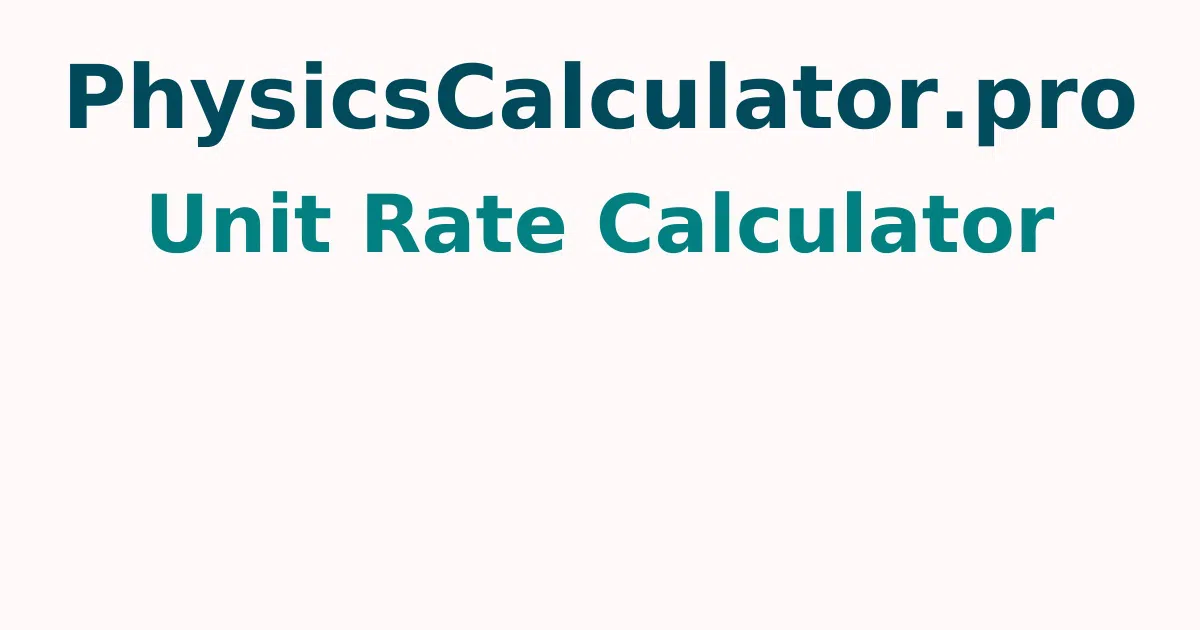Unit Rate Calculator
The unit rate calculator developed by us can be used to get the unit rate of quantities for any such comparison effectively and efficiently. For instance, if the two quantities and their units are entered in the calculator, the calcualtor will simplify and go to the calculations of the fraction and give the result as a unit rate for any comparsion.
Unit Rate Calculator: A unit rate is defined as a ratio comparing quantities of different items but with same units. A unit rate is a rate with 1 in the denominator of any such comparision. If the user have a rate, such as price per some number of items, and the quantity in the denominator is not 1 in such comparision, then this can be calculated as unit rate or price per unit by completing the division operation: numerator divided by denominator.
What is a Unit Rate?
It is the same thing but with the second number equal to 1 in the denominator of the fraction. Or, if owing to a more scientific unit rate definition, it is a way to translate the rate as we have it into the equivalent fraction with the denominator 1 for any such comparison.
How to find the unit rate?
Finding unit rate is quite an easy method to learn, let us know-how. Suppose a user has two numbers, a and b. Then their rate is a / b, but what is the unit rate of such comparison?
From the unit rate definition, we know that it is the equivalent fraction with denominator 1. In other words, we want to find the c which satisfies the equation for this comparison.
a / b = c / 1, which is simply translates to: a / b = c.
This already suggests what we must do: we divide a by b, and whatever the result we get is called the unit rate.
Unit Rate Examples
Question 1:
The pottery store in rural India can make 176 coffee mugs in an 8 hour day, by manual labour. How many mugs can they make in one hour?
Solution:
To find out the number of mugs made per hour unit, we set up a ratio with hours in the denominator of this comparison. The total number of mugs made per day goes in the numerator. So the fraction comes out to be 176/8.
Complete the division: 176 ÷ 8 = 22.
Hence one can conclude that the per hour mug-making unit rate is 22/1. The pottery store makes 22 mugs per hour (22 mugs per 1 hour = 22/1).
Question 2:
Aryan can run 12 laps in 30 minutes. How many laps does he run per minute?
Solution:
We want to know the laps per minute unit so we set up a ratio with minutes in the denominator of this comparison. The total laps go in the numerator. So the fraction is 12/30.
Complete the division: 12 ÷ 30 = 0.4.
So the per minute lap unit rate is 0.4/1. Aryan can run 0.4 laps per minute (0.4 laps per 1 minute = 0.4/1).
Question 3:
Ronit purchased 3 apples for $1.80. What is the unit price, or the cost of one apple?
Solution:
We want to know the price per apple unit so we set up a ratio with the number of apples in the denominator of this comparison. The total price goes in the numerator. So the fraction is 1.80/3.
Complete the division: 1.80 ÷ 3 = .60.
Hence, the per apple price unit rate is $0.60/1. Ryan paid a unit price of $0.60 per apple (60 cents per 1 apple = .60/1).
FAQs on Unit Rates
1. What is the meaning of unit rate?
Unite rate is a unit that compares two units i.e. how many units of the first type of quantity corresponds to one unit of the second type of quantity.
2. What are a few examples of unit rates?
The unit rate is very common in day to day life. A few examples of unit rates are kilometre per hour (km/hour), cost per litre, profit per item, etc.
3. How do you find the unit rate in math?
To find the unit rate, divide the numerator with the denominator to make the denominator 1.
